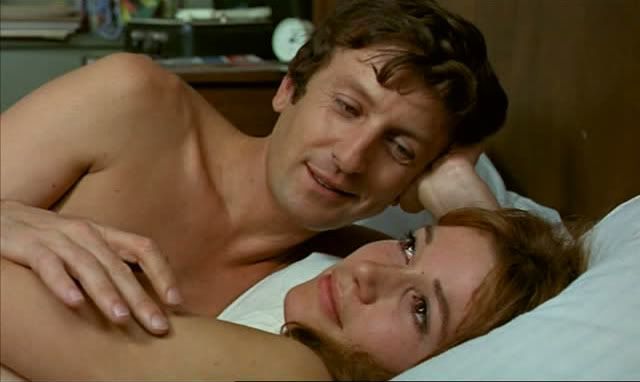
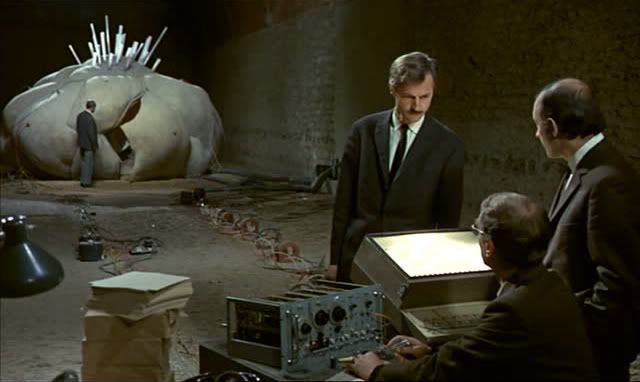
Alain Resnais has always been concerned with time and memory, and his best-known films revolve around these themes with almost obsessive dedication, as though locked into compulsive loops in which the same ideas recur with rhythmic regularity. The signature cinematic technique of his art is the edit, the cut, which is quite natural for a director so concerned with time. The art of montage is the art of arranging and controlling the flow of time; the editor shapes the raw material of a film, deviating from the linear progression of the shoot to arrange the scenes and shots in ways that express ideas, or tell stories, or create emotional juxtapositions between images. Editing reaches its apex as an expressive form in Resnais' art, and especially in Je t'aime, je t'aime, a film whose structure very cleverly mirrors the editing process, embodying the art of editing in the film itself. It's one of Resnais' very best films, a sci-fi time travel masterpiece in which the publishing executive Claude Ridder (Claude Rich), after recovering from a suicide attempt, is enlisted by a secretive research firm for a potentially dangerous experiment. The anonymous, unnamed scientists want to send Claude back in time as their first human research subject, reasoning that since he hadn't wanted to live, he didn't have much to lose if the experiment went wrong.
This experiment is supposed to send Claude exactly one year back in time, and he is supposed to remain in this time for exactly one minute before returning to the experimental chamber, a cushy, womb-like enclosure that from the outside, absurdly, looks like a misshapen brain or a vegetable or a hybrid pileup of curved human body parts. Instead, Claude becomes unmoored in time, blinking in and out of the present (another editing trick, that) and reliving a shuffled series of moments from throughout his life. Moments in time become unpredictably, randomly pulled out of context, so that Claude's life flashes before his eyes — and our eyes — out or order. Key moments are repeated, scenes are cut off abruptly and may or may not be continued or expanded later, surreal visions that might be dreams butt up against real memories, and several dramas and mysteries slowly emerge from this fragmented view of Claude's life.
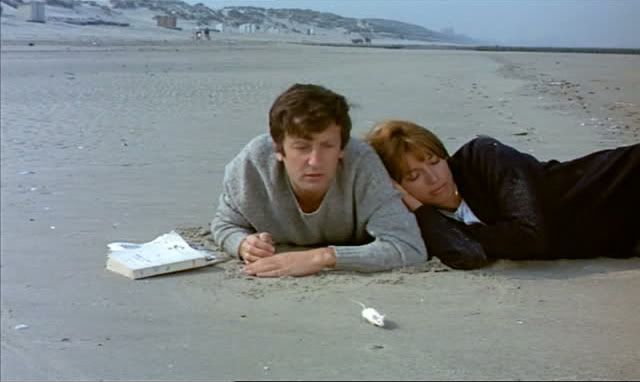
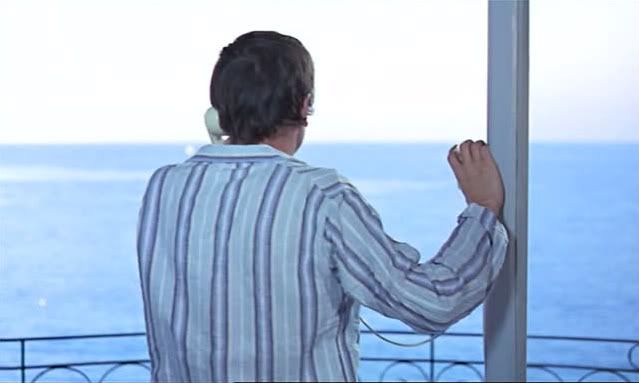
The focus of his memories is his wife, Catrine (Olga Georges-Picot), whose death triggered Claude's own suicide attempt. The couple's troubled relationship dominates the memories that Claude relives, leaping non-chronologically from their first meeting to the later unhappy stages of their relationship to its possibly violent ending. They meet, they fall in love, they argue. Claude is unfaithful and Catrine is perpetually depressed, and it seems like far from an ideal relationship, although the fractured chronology makes it difficult to tell if the couple's relationship started in one state and progressed towards another, or if they were continually bouncing back and forth from better times to worse ones. The shuffling of narrative chronology eliminates the linearity from a person's life, so that each individual moment stands on its own, the moments of tenderness (the sweet love scenes in which the couple exchanges loving words) and the moments of cruelty and darkness (the scene where Claude casually confesses his infidelities while saying he still loves his wife).
Cause and effect are blurred, to a degree, so that it's no longer possible to think of one scene leading into the next, and the lack of clear indicators of time and place means that the order in which things occur is frequently unclear except when the dialogue drops enough contextual clues to figure it out. But if time travel makes Claude's life a puzzle, it's obvious that Resnais doesn't mean for the audience to reassemble the pieces: there are too many pieces missing, too many that don't fit, too many gaps. There is a genuine mystery here, some uncertainty revolving around how exactly Catrine died, but the mystery is not the point: the core of the film is the emotional intensity of re-examining one's life, rifling through the archives of memory and finding all these moments and images that evoke nostalgia, or regret, or happiness, or despair. The way things fit together in the end hardly matters; Claude already knows how things end, even if the audience doesn't quite yet, and his experience of his life as an out-of-order flow of scenes both banal and earth-shaking is what the film is all about.
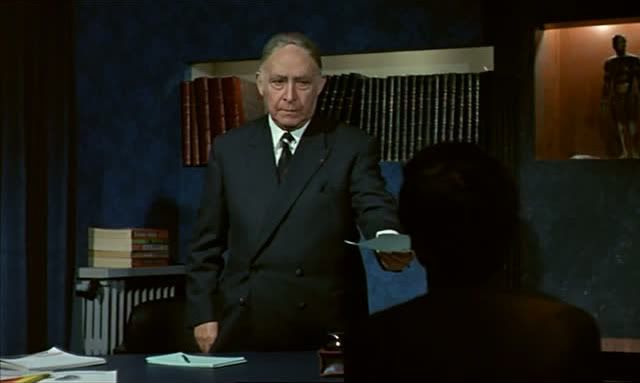
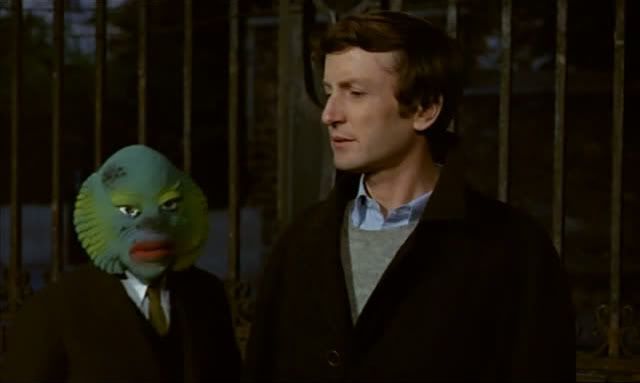
The mystery is also largely rendered irrelevant by the sense that the film is really exploring the distorting effects of memory, the ways in which memory can lie and obscure rather than revealing the truth. Resnais is concerned with the selectivity of memory, and for much of the film several key scenes are occluded, perhaps because Claude is on some level subconsciously directing the images that flash before his eyes. At other times, it seems like his memory is rebelling against the staid confines of reality, creating surreal disjunctions and weird interludes that suggest that not only can memory lie, it can go mad.
In several scenes, dreams filter into reality, as when Claude remembers a sexually charged encounter with a beautiful woman, and the woman appears, stretching her shapely leg up into the air, in a bath tub that's ludicrously placed in the middle of Claude's office. That woman appears again later in a scene that's presumably the source of Claude's erotic dream/vision, but the "real" scene has a similar absurdist visual sensibility, since the woman appears twice, reflected in mirrors on either side of Claude as though he were being asked to choose between two identical women. Indeed, he occasionally does seem to confuse his many women, as in a scene where the woman he's in bed with shifts between cuts from Catrine to several other women before settling back into his wife again; the bed and the room change as well, as Claude's mind mashes together different scenes with women from throughout his life, his erotic adventures all blending together. Other scenes are utterly inexplicable, ripped out of context as surreal intrusions of the subconscious: a man drowning while speaking on the phone, a short figure in a suit and a green reptilian mask who walks alongside Claude without saying a word.
The film also shuffles the chronology of Claude's career at a publishing firm, where he progresses from working in the mail room to a mid-level office drone to an executive position. The scenes of work are almost always deadening and numbing, and though Claude's progress upward through the company is not presented in a linear fashion as he skips from memory to memory, it gradually becomes clear that the only time when he was actually happy or contented at work was in the stock room, mindlessly stacking magazines for shipping. The more responsibility he gets, the higher he rises, the more miserable he becomes. At one point, he sits at his desk with glazed eyes, musing about how slowly time passes, how it seems like it will remain the same time forever — a memory that acquires a very different resonance when shuffled into Claude's jaunt through the past. In another scene, Claude sits at a desk working while men in business suits are clustered around him, commenting disparagingly on his ability to finish the project he's working on. With the dark setting and the shadowy figures arranged around the desk, towering over Claude, it's staged like a nightmare, a paranoid fantasy of workplace pressure, another expression of Claude's subconscious rather than a literal memory of something that actually happened.
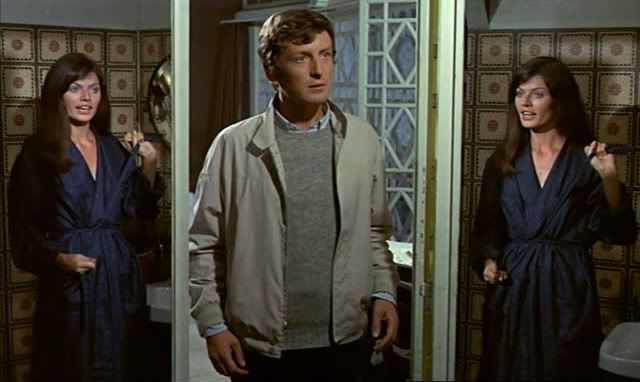

The film's more surreal diversions confirm that Resnais has a sense of humor about this sci-fi material, deliberately skewering the conventions of the genre in the deadpan scenes leading up to Claude's experiment. The scientists take him on a tour of their facility, showing him a mouse that they insist has successfully traveled in time, though they joke that they can't be sure since the mouse can't talk; how short-sighted, Claude says, they should have taught the mouse to talk first! The mouse, who accompanies Claude on his own time travel trip in a plastic bubble, shows up at random in Claude's memories, scurrying across the beach while Claude and Catrine lounge in the sand.
The mouse is a physical manifestation of the unreliability of memory, as it scurries into memories where it previously hadn't existed, its presence distracting Claude from the moment; is the mouse actually changing the past, or only changing Claude's memories of the past? Another animal, the cat that Catrine and Claude keep as a pet, appears, it seems, only when Claude remembers that it exists. Suddenly, once the cat is mentioned, they have a cat. The memory that they have a cat seems to shift the cat into existence, or back into existence. It raises the question: can something be said to exist, or to have happened, if we don't remember it? It's as though memory is populating and creating the world through its functioning. Claude's wartime memories, which similarly seem to be unreliable, are an interesting and unresolved undercurrent in the film. He refers several times to his experience in the army during World War II, which contradicts his frequent assertion that he dislikes guns and doesn't know how to use them — but then again, his chosen method of suicide also contradicts this statement. In a very puzzling scene that's unconnected to virtually everything else in the film, Claude runs across an old man who, he claims, gave Claude fake documents and a new identity during the war. The old man protests that he doesn't remember Claude, and says that it's impossible, that he too got a new identity during the war. It's a very mysterious scene, suggesting that there's a lingering mystery in Claude's past, even in his identity. Is memory really so fragile, so malleable?
That question is at the heart of Je t'aime, je t'aime. The film's minimal sci-fi story provides a framework and a clever conceptual container for Resnais' consideration of the nature of memory. As Claude hurtles through time, each memory he encounters might or might not provide additional context for the scenes that surround it, sometimes completely altering the understanding of another memory or casting other memories in a different light, at other times existing independently as self-contained stories or scenes. It's a film that acknowledges that a life can seldom be completely understood, and that the retrospective filter of memory can provide many different vantage points on that life. Its construction, a parallel for the process and artistry of filmmakers, suggests that we're all filmmakers and artists in our own minds, that the life stories we construct for ourselves are mental films, scenes projected in endless loops, moments edited together into semi-coherent assemblages that don't tell stories so much as replay emotional highlight reels.
Wonderful! I adored "Last Year in Marienbad" and Je t'aime sounds perfect. Thanks for the post.
ReplyDeleteOh I'm so glad you're writing about this! It's one of my very favorite Resnais' -- but sadly one of his least known.
ReplyDeleteIt's obvious twin is Marker's . But time travel there is different in that involves people meeting within a time-slip who have no previous history. Je t'aime Je t'aime is all about the hero's past. What makes it so witty is that the moments we see vary fromobviously "important" ones (major conflicts with Olga-George Picot) to random "unimportant" onces (Calude Rich waiting or a bus. Jacques Sternberg is a highly regarded French sci-fi writer, unknown to the English-speaking world.
The mouse in this film looks forward to the mice in Mon Oncle d'Amerique.
Also watch closely as Alain Robbe-Grillet has a brief acting role here.
Marke's Jetee (I meant to post.)
ReplyDeleteI love Olga-Georges Picto's monologue about the notion that the entire universe was created not for man but for cats.
This ties in with the cat-obsessions of the "Left Bank Group" (Resnais, Varda, Marker -- who when asked for a ersonal poto always sends a picture of a cat.)
Major influence and forerunner to Eternal Sunshine of The Spotless Mind (and Annie Hall too I suppose). I loved the film, although it tested my patience for the first 20 or 30 minutes... it is well worth sticking to though, great, poignant rewards are given for it.
ReplyDeleteJohn, if you liked Marienbad (many don't, unfortunately) this should be right up your alley.
ReplyDeleteDavid, it's one of my favorites, too, an absolute masterpiece if you ask me. It should be as acclaimed as any of Resnais' better-known 60s films. I love that cat speech. So many charming bits and pieces here: as you say, the time travel structure allows for many scenes that are "unimportant" in terms of plot but very satisfying on their own terms.
Tim, agreed that this must be a big influence on Gondry's film. It's such a witty, intelligent approach to sci-fi.
Thank you so much for posting this! Resnais is brilliant, I'm just starting to get into his films and reading this helped me grasp Je T'aime, Je T'aime. Such a nice deviation from his very straight-faced, earlier films (don't get me wrong, I still enjoyed them a lot).
ReplyDelete